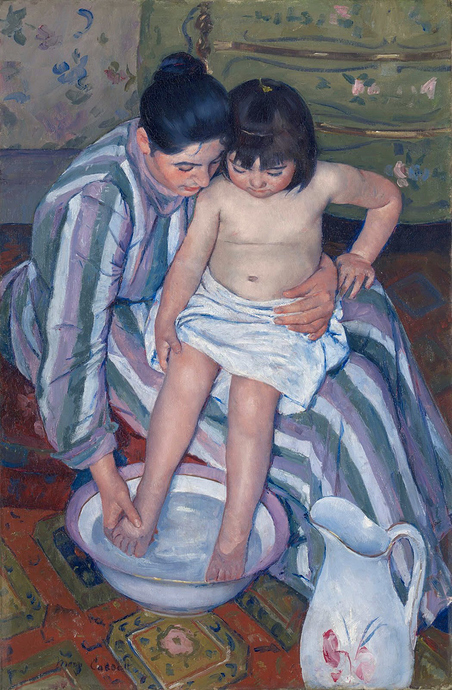I don’t want to get too arty here, but I’m going to anyway because the visual flow of composition is important for all hype users.
Take a look at Mary Cassat’s “The Child’s Bath” (1893) (An American painter who was a key figure in the French art circles of her day.)
What you see first in the composition is dead center. The child’s hand and leg point to the mother’s hand as it washes the foot. The bowl swings your eye around the other leg, upwards to the elbow, across the two faces, then it follows the stripes on the mother’s arm back down to the hand again.
As you continue to explore, the angle of the white towel and the direction of the striped on the dress take you directly to the pitcher. Your eye follows the oval shape of the pitcher down, around, and up to the lip, which leads the eye to take a dive from the lip of the pitcher, into the bowl and back into the circle of motion.
As this is going on, a number of messages are being delivered: the closeness of the two faces has meaning. The round and round motion conveys a rhythm like a scrubbing motion, which represents the action being depicted.
One more hidden thing is that the motion is counter-clockwise. This is because most people are right-handed and we tend to feel more comfortable with things rotating clockwise than counter-clockwise. This was done because it makes you pause for a microsecond at each waypoint and you have to work at it. This is extremely intelligent. Taking is as nothing more than a painting, it is pretty ordinary, but when you think of the extreme sophistication of the composition, this is how a painter might be defined as a genius.
This is one of the most authoritative examples of this that I know of.
To me, an understanding of the directive nature of visual composition is key to a good composition in motion graphics. When designing, it is a good idea to provide a visual sequence so that the intent of the composition is expressed in more ways than by a number of moving objects, each of which is fighting for attention. Start by focusing attention on the noun (the visual title or starting point of your message for that scene). Then lead the eye to the verb (the main action / the fun part). Then finish with the adjective. (Are you into Haiku? Same principle.) You want the viewer to focus on the meat - the second stage – then have time to take it in, then finish with a bang that either underscores the main message or extrapolates, such as adding something unexpected and pithy. It is like the punchline of a great joke.
Motion graphics is as much about conveyance as message.
 .
.
